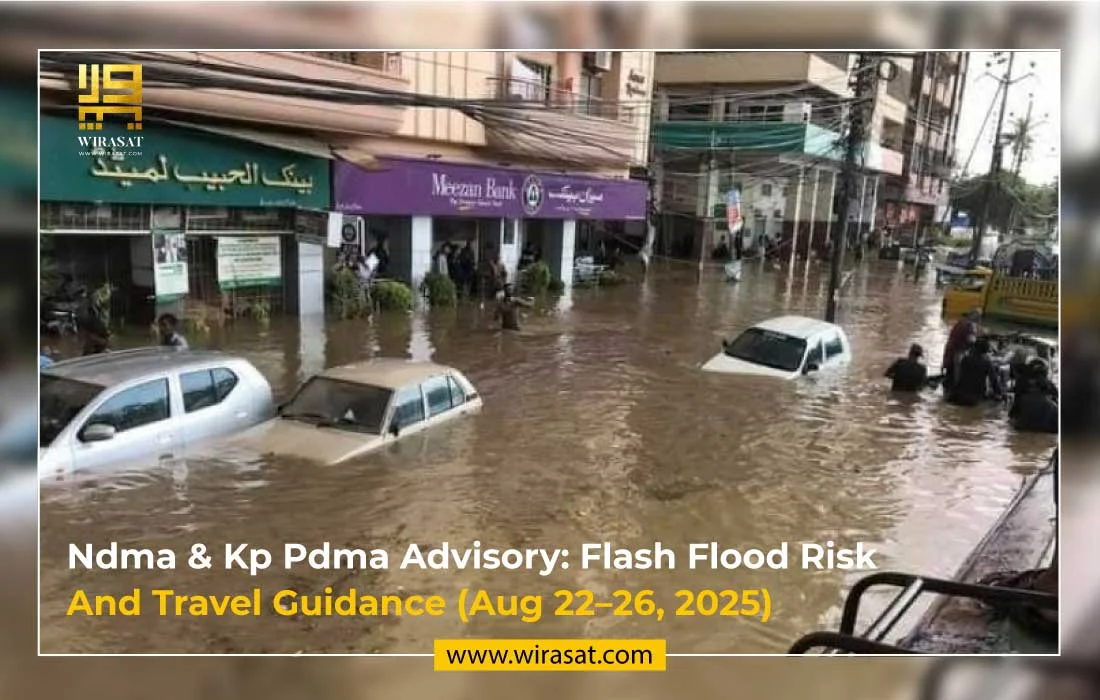NDMA & KP PDMA Advisory: Flash Flood Risk and Travel Guidance (Aug 22–26, 2025)
If you are planning to travel in northern Pakistan over the next few days, here’s the advisory guidelines issued by the concerned authorities. The National Disaster Management Authority (NDMA) and Khyber Pakhtunkhwa Provincial Disaster Management Authority (KP PDMA) have issued alerts for heavy rain, thunderstorms, landslides, and flash floods through the last week of August.
Time window: Aug 22–26 for upper and central regions. PMD also flags Aug 27–29 for heavier rains in Sindh and eastern/southern Balochistan.
Which areas and hazards are on alert now?
According to the NDMA report, in the last week of August, Pakistan is to receive heavy to very heavy rainfall from Gilgit till Balochistan and Sindh. There are high chances of flash floods, landslides or rockfalls in northern Pakistan. There could be heavy to very heavy rain, across different regions of KPK. There are also high risks of a flash-flood in nullahs/streams and a high chance of landslides in hilly districts of KPK. The regions that are prone to danger are Galiyat, Abbottabad, Mansehra, Kohistan, Dir, Swat, Shangla and other nearby locations. Urban flooding is also expected in low-lying areas.
NDMA guidance urges the public and travelers to be careful around loose structures and to avoid exposure during rain and wind. These instructions are specifically to caution tourists in mountainous areas due to flash floods, landslides and rockfall. Power utilities may face disruptions during the monsoon spells.
The National Disaster Management Authority’s advised the public beforehand not to wade or drive through floodwater. Travellers should avoid trekking/camping in heavy rain, and prefer local drivers on hilly terrain in this season. The uneven and slippery roads can lead to disasters so people should avoid driving.
If you must travel, do this:
Many doctors, rescue operations, and refugee camps have to travel to minimize the destruction. There are many other professionals or if someone has to reach their families, they must travel. Before you travel to the risky areas, check the safe route update of your destination and weather forecast. If you see flood or landslide alerts and warnings on your roadway, you should delay your journey until the weather is safe.
You should also pack water, flash lights, snacks, light layers, a small first aid-kit and essential medicines in your bag. Keep a printed list of helplines, route maps and local contacts in case the network drops in the area. The next step is to share your route and ETA with your family to keep connected in the severe conditions. Keep your phone charged and carry a power bank along with it as there might be power disruptions.
When you are on the road, never enter water flowing across a road. Many drivers think they can control their vehicles but the water flow is so strong that it carries away everything that comes in its way. Many bikes and cars have been swept away in the last flash floods of Swat, Buneer and nearby areas. The water flow has also driven many cars away and their parts such as bumpers, headlights were then found. Even shallow or low water currents can also sweep away vehicles. That is why people should not stay near an area that is prone to flooding. If you see strong water flow, immediately shift to a safer place. Keep a safe distance on the road edges and from other vehicles.You should also avoid overtaking on blind turns and in fog. While driving, keep your speed slow and watch out for falling rocks after cloudbursts. If you are stuck in an area, park your vehicle on a safe side and wait for an official clearance announcement.
Guidelines for hotels, glamps, and tour operators
The hospitality sector in the tourism real estate plays a key role in this situation. Many people from Punjab and Sindh, especially do not know the severity and the overall weather conditions of the region. That is why, hotels and resorts should step up for the safety of tourists. They should push pre-arrival WhatsApp updates to guests by 9–10 am with the route status for that day. Many roads are blocked due to landsliding or flooding risk. Assign a staffer per shift to confirm road status via official helplines and log updates. Keep vehicles fueled, basic first aid ready, and a safe indoor waiting area for guests if roads pause. Reconfirm pick-up points away from vulnerable nullahs or steep bends. Share clear options if a route closes, then wait, reschedule, or refund ride fare. These steps align with NDMA’s safety guidance for tourists and the general public during rain and wind events.
Useful helplines and contacts
- KP Tourist Facilitation Hub (24/7): 1422. For live travel guidance anywhere in KP.
- Galiyat Development Authority Control Rooms: 0992-355539 (Nathiagali) and 0992-357040 (Changla Gali).
- NDMA UAN: 051-111-157-157 | NDMA WhatsApp: 0300-0881641.
Frequently Asked Questions (FAQs)
Aug 22–26 in upper and central Pakistan, with further heavy rain signaled for Aug 27–29 in Sindh and eastern/southern Balochistan. Check morning updates on your travel day.
In and around hilly districts and stream belts, including Galiyat–Abbottabad, Mansehra, Kohistan, Dir, Swat, Shangla and others named by PDMA.
Authorities advise caution. Avoid trekking or driving unfamiliar steep roads in rain, avoid water crossings, and do not stand near loose structures or trees during winds.
KP: Chitral, Dir, Swat, Shangla, Kohistan, Kolai-Palas, Malakand, Buner, Mansehra, Battagram, Torghar, Abbottabad, Haripur, Swabi, Mardan, Nowshera, Charsadda, Peshawar, Bajaur, Mohmand, Khyber, Orakzai, Kurram, Kohat, Hangu, Karak, Bannu, North Waziristan, South Waziristan, Lakki Marwat, Tank and Dera Ismail Khan. PDMA flags flash-flood risk in local streams; NDMA highlights Galiyat–Mansehra–Kohistan–Abbottabad belt in particular.
Punjab: Northern/central districts under widespread rain include Rawalpindi, Murree, Attock, Chakwal, Jhelum, Mandi Bahauddin, Gujrat, Gujranwala, Hafizabad, Wazirabad, Lahore, Sheikhupura, Sialkot, Narowal, Nankana Sahib, Sargodha, Mianwali, Khushab, Chiniot, Faisalabad, Jhang, Toba Tek Singh, Sahiwal, Kasur and Okara; southern belt includes D.G. Khan, Bhakkar, Layyah, Multan, Bahawalpur, Bahawalnagar, Khanewal, Pakpattan, Vehari, Lodhran, Muzaffargarh, Rajanpur, Rahim Yar Khan and Kot Addu. Urban-flooding risk is noted for major cities.
Sindh: Rain-wind/thundershowers signaled for Mithi/Tharparkar, Umerkot, Mirpurkhas and Larkana in this window, with heavier activity expected province-wide Aug 27-29.
Balochistan: Barkhan, Musakhel, Loralai, Sibi, Zhob, Kalat and Khuzdar are listed for rain-wind/thundershowers this spell, with heavier rains flagged for eastern/southern Balochistan Aug 27–29 and hill-torrent risk.




